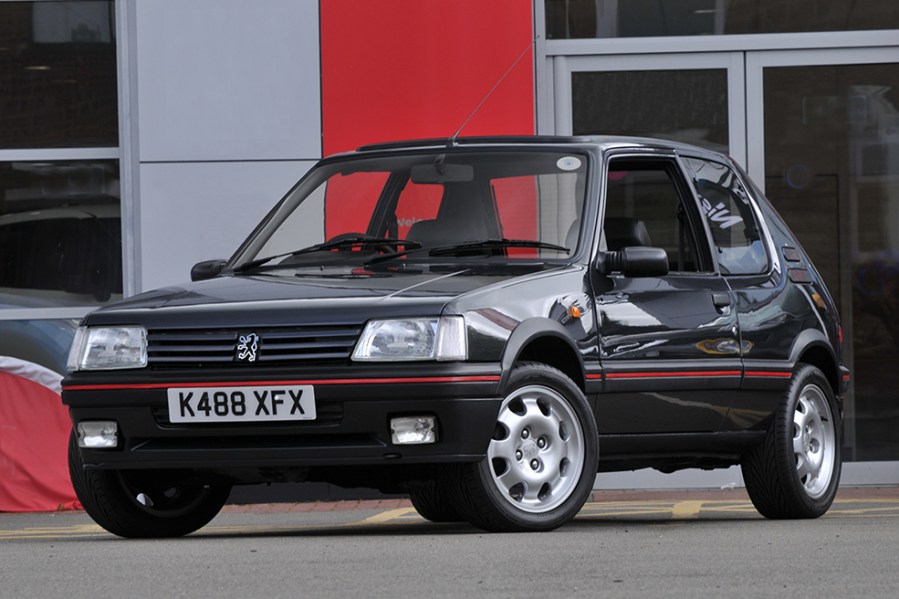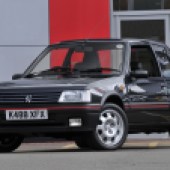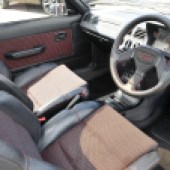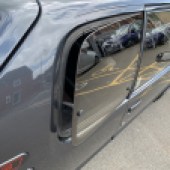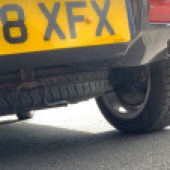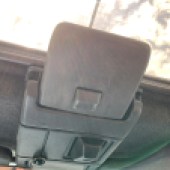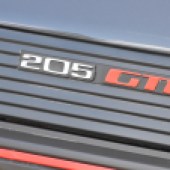We revisit the iconic Peugeot 205 GTi in legendary 1.9 guise. Does it still live up to the hype?
Words: Paul Wager
They say you shouldn’t meet your heroes but in this case it would also seem like a bad idea to revisit them. Not because the passage of time has dulled the feisty spirit of the iconic hot hatch you see here but because the sticker in the screen of this low-mileage, exceptionally tidy example makes me wish I’d held on to the identical example I sold many years ago. And when you factor in the little detail that the 205 GTi was kept company in the garage by an Escort RS Turbo you can see where the regret comes in… put the two together today and you could wave goodbye to most of the mortgage.
Anyway no use crying over red pinstripes and all that; rising interest rates aside, it was a joy to revisit the iconic Peugeot, especially since the only examples I’ve sampled in more recent years have generally been timeworn examples of the smaller 1.6 model.
It was this which was the first of the GTi models to appear, arriving a year after the regular 205 models in 1984. The 205 itself was a replacement for the boxy Peugeot 104 and what’s often overlooked is that it was absolutely critical for the company which was struggling financially at the time thanks to a conservative product range. It was these financial constraints which forced the carry-over of the 104’s ‘Douvrin’ gearbox-in-sump engine and MacPherson strut front suspension, paired with a space-saving torsion beam axle using heavily inclined dampers for the rear end.
Key to the car’s success of course was its sheer style, created by an in-house team under Gérard Welter, a genius move being to relocate the spare wheel from the engine bay in order to lower the car’s nose. That the spare wheel ended up in a cradle under the rear would later be a gift to alloy wheel thieves across the UK. And that elephant in the room wearing a Pininfarina badge? The Italian design house in fact engineered the convertible version of the car for production which is where the often-quoted association comes from.
To create the GTi, Peugeot borrowed the alloy 1580cc XU engine from the Citroën BX GTi which with its 105bhp was enough to propel the lightweight French flier to 60mph in 8.6 seconds and on to a busy 118mph.
This was on a par with the Golf GTI’s 8.2 seconds and 114 mph, but straight line speed wasn’t what the 205 GTi was all about. It was the car’s sheer chuckability which made a Golf seem cumbersome and an XR3i simply wooden, and which also answered those critics who felt that a rear-drive layout was the only way to go for driving thrills.
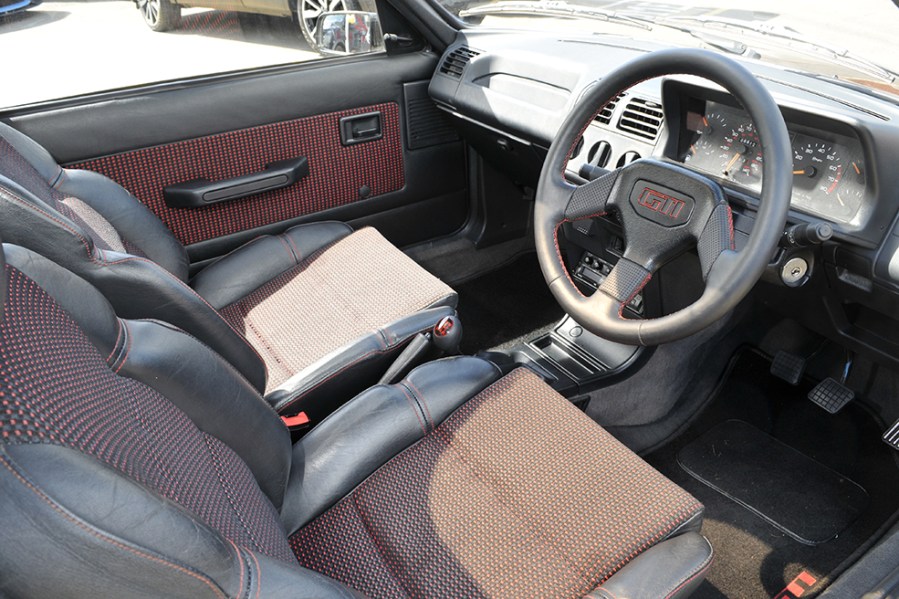
The success of the 205 GTi took even VW by surprise and in 1986 the Golf gained an extra camshaft to become the 16V model. The same year Peugeot fired back with an upgunned 205 featuring the 1905cc version of the XU engine rated at 128bhp.
Distinguished by its Speedline wheels and half-leather interior, the 1.9 GTi offered a very different character from the original GTi, with the longer-stroke XU9 engine majoring on torque rather than the rev-happy fizz of the smaller XU5 unit.
Key to the giant-killing pace of both GTi models however was a slender kerb weight and nimble chassis which with the extra power of the 1.9-litre engine translated to cross-country pace which had the measure of most blue chip supercars.
Turn-in was unusually sharp for a front-driver of any description in that pre-Focus generation, paired with the 205’s equally lively rear end which was notorious for going light when unloaded in a bend.
The resulting lift-off oversteer has become something of a cliché where the 205 GTi is concerned but in reality nothing dramatic happened unless you were really cranking along and snapped the throttle shut mid-bend on a damp surface, at which point you probably deserved everything which happened from that point onwards. In reality, a Golf would have understeered into the same ditch while a 325i would still have been spinning as it burst through the hedge and in most fast-road usage that light rear end was something which could be used to a keen driver’s advantage.
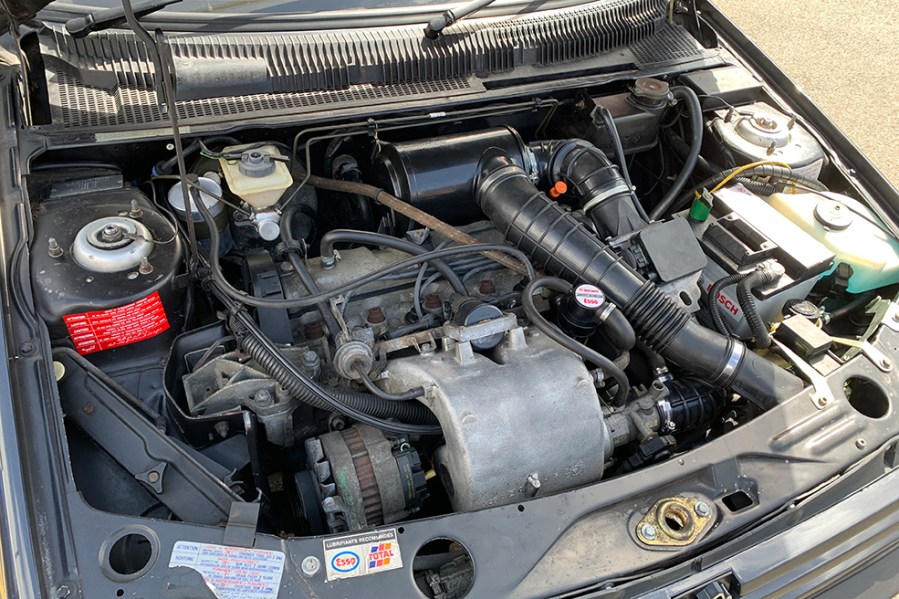
As any previous owners will know, the 205 is a brilliant car but at the end of the day it was made in France in the 80s which even without a helping of Brexit-fuelled jingoism translates to an, ahem, lightweight build. Couple this with the way these cars encourage you to drive and it’s no surprise that immaculate examples are hard to come by today – especially unmodified cars.
But this is one such example and is very much the tidiest we’ve come across in the last couple of years. Notoriously flimsy trim pieces like the handle for the pump-up sunroof are undamaged and the body sides are unusually straight and free of car park dings. Back in the day Peugeots of this vintage were noted for their tendency to ripple easily, with several theories advanced to explain it, one being the high carbon content of the steel but there’s none of that here.
Clued-up readers will already have spotted the K plate on this car, its May 1993 registration making it one of the very last. UK sales of the 205 would end in 1994, while the 1.6 GTi had disappeared in 1992, the smaller engine unable to meet increasingly stringent EU emissions requirements – notably a catalytic converter – without an unacceptable drop in performance. Even the 1.9 GTi suffered, falling to 122bhp in catalysed form.
On the flipside, late models like this came with the option of power steering, which was something I was grateful for as I manoeuvred the car for our photos; I instantly recalled my own example as being hard work to park, especially with the constant fear of kerbing those signature alloys.
Also familiar was the instant throttle response, something so often missing from even the sharpest of today’s hot hatches and something which made the GTi famously tricky to drive smoothly in stop-start city traffic – certainly once you’d mastered it, you were in an elite circle.
Leave the traffic behind though and you can start to consider the 1.6 versus 1.9 debate. Over on our YouTube channel, colleague Joe Miller’s road test film of a 1.6 GTi (see above) has picked up a few derogatory comments along the lines of the 1.9 being far better, but it’s really not as clear-cut as that. For one thing, far fewer 1.9 models were sold and even fewer have survived, making it harder to source in the first place. The driving experience is also very different; sure, the 1.9 is ultimately faster and its greater torque offers mid-range punch which eclipses the 1.6, but for a keen driver the 1.6 has an eager feel lacking in the bigger-engined car. Ultimately, both offer the same serving of fun but in a different way and neither will disappoint as a modern classic.
Shake the traffic free and whether you find yourself on twisting country lane or A-road it’s immediately obvious why these cars gained icon status even when they were still in production. The compact size and large glass area makes them easy to place on the road, while the sheer lack of mass is really noticeable in comparison to modern performance hatches; obvious in that sharp turn-in and modest body roll. The tall, spindly gearlever might not match the precision of steering and general poise but it works well enough and certainly in the 1.9 anyway doesn’t need stirring too frequently.
Impressively, but perhaps unsurprising for a French car, Peugeot also managed all this with a civilised ride. Naturally the GTi is firmer than the roly-poly regular models but with its modest – by modern standards – 195/50 rubber on 15-inch rims it’s less bouncy than a modern MINI and less crashy than a contemporary Golf GTI over potholed surfaces.
All of which of course explains exactly why the 205 GTi was so popular back in the day and I’m pleased to say that its appeal hasn’t been diminished by the passage of time and certainly it remains head and shoulders above the Escort RS Turbo. Perhaps there is a case for revisiting your heroes after all.

